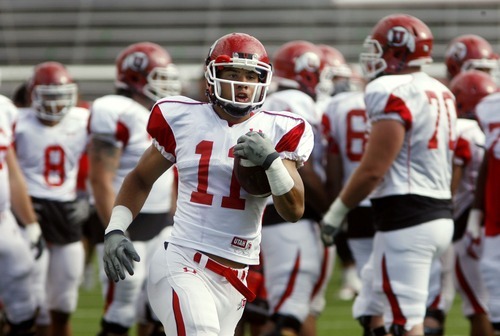This is an archived article that was published on sltrib.com in 2011, and information in the article may be outdated. It is provided only for personal research purposes and may not be reprinted.
When the Pac-12 Conference announced its record-breaking new television contract recently, everybody seemed to know just how the Utah Utes should spend the estimated $21 million they eventually will receive every year as part of the deal.
Expand the stadium!
Build a basketball facility!
Add a new sport!
But it's not quite that simple.
Although it might have felt as if the Utes had just won the lottery and needed to decide immediately whether to buy a Porsche, fly around the world or put in a pool, the fact of the matter is that the Utes — for the moment, anyway — need to focus first on simply fixing the fence and sprucing up the yard in order to start measuring up to their wealthy new neighbors.
"There's going to be some growing pains, financially," athletic director Chris Hill acknowledged.
That's because the Utes will enter the Pac-12 on July 1 with by far the smallest athletic budget in the league, about $31.8 million a year, according to the most recent data available from the U.S. Department of Education.
That's nearly 20 percent lower than the next-lowest — the annual athletics revenue at Washington State is $39.3 million — and only about half as large as the top five teams in the league. Stanford's budget is a mammoth $81.7 million a year, followed by USC ($75.7 million), Oregon ($75.4 million) and Cal ($69 million). And that means the Utes have a long way to go just to stand on the same foundation as some of their new rivals, let alone enjoy some of the extravagances that others do.
"We have to step it up — there's no question," Hill said. "There is no question that we're going to be in the bright lights, and we have to support our program that way. Everybody has to jump on board. Everybody."
By that, Hill means not just coaches and athletes, but fans and boosters, too.
Ticket prices for football games already have started rising — between 20 and 24 percent for most seats at Rice-Eccles Stadium next season, with all except bleacher seats also requiring a donation to the Crimson Club — in an effort to generate more revenue.
The Utes hope to make more money from booster donations and licensing once they're in the Pac-12, too, and take advantage of lower tuition costs than other schools, which allows them to spend a smaller portion of their budget on scholarships.
"The charge is for every one of our resources to grow," Hill said.
Yet even once the Utes start receiving a full share of the revenue from the new $3 billion television deal in the 2014-2015 season, Hill said they will have to carefully prioritize where they spend, in order to reap the most reward. Football and men's basketball is "obviously … where we need to invest" first, because of their ability to generate greater return on investment.
"You have to get there quickly" on the revenue producing sports, Hill said. "The frustration will be, we might not be able to get there as quickly with everybody that needs us to. But we have to close that gap."
Mostly, that means investing in more modest ways that can have an outsized impact, rather than luxuries such as a massive stadium expansion that would keep the Utes from being able to upgrade in other areas.
The Utes have introduced plans to expand their football headquarters on Guardsman Way, for example, at a cost of at least $16 million. They are also adding an athletic trainer and an academic adviser to their staff next season and have already hired an extra employee in the compliance office to "make sure we're on top of everything" as they enter the only league in the nation with its own rules enforcement division.
Hill also aspires to gradually raise coaching salaries to more closely match the level found in the Pac-12.
"There's a gap there," he said, "and we have to get after it."
At first glance, the Utes appear poised to make up ground quickly, once the money from the new television contract starts arriving in the 2012-2013 season.
The Utes will get only a 50 percent share of the distribution that year, as part of their deal to join the league, but that represents a greater portion of their overall budget than does a full share to some of the biggest schools. Shares will average $21 million over the course of the 12-year deal, but will be smaller than that, initially.
Same thing when they receive a 75 percent share in the 2013-2014 season.
But partial shares will do less for the Utes than full shares will do for some of their more comparable rivals in the next few years — Arizona, Oregon State, Colorado and WSU all have budgets between $39 million and $57 million — especially considering that many of those opponents have already made some of the investments that the Utes still need to fund.
Therein lies the challenge, particularly with sports other than football and basketball.
"We're trying to help as many as we can," Hill said. "There's so many variables. Do they have the potential to get us more visibility? Do we have the athletes in place to be successful? Do we have the recruiting budget? There's like five or six variables. Can they have the potential to generate money? Do they have a chance to win a Pac-12 championship? All those things go into prioritizing, and there's so many different variables that there is no set answer.
"The one thing we don't want to do is make somebody feel like they're not a priority," he added. "It may take some sports longer … but we're trying to get there as fast as we can."



